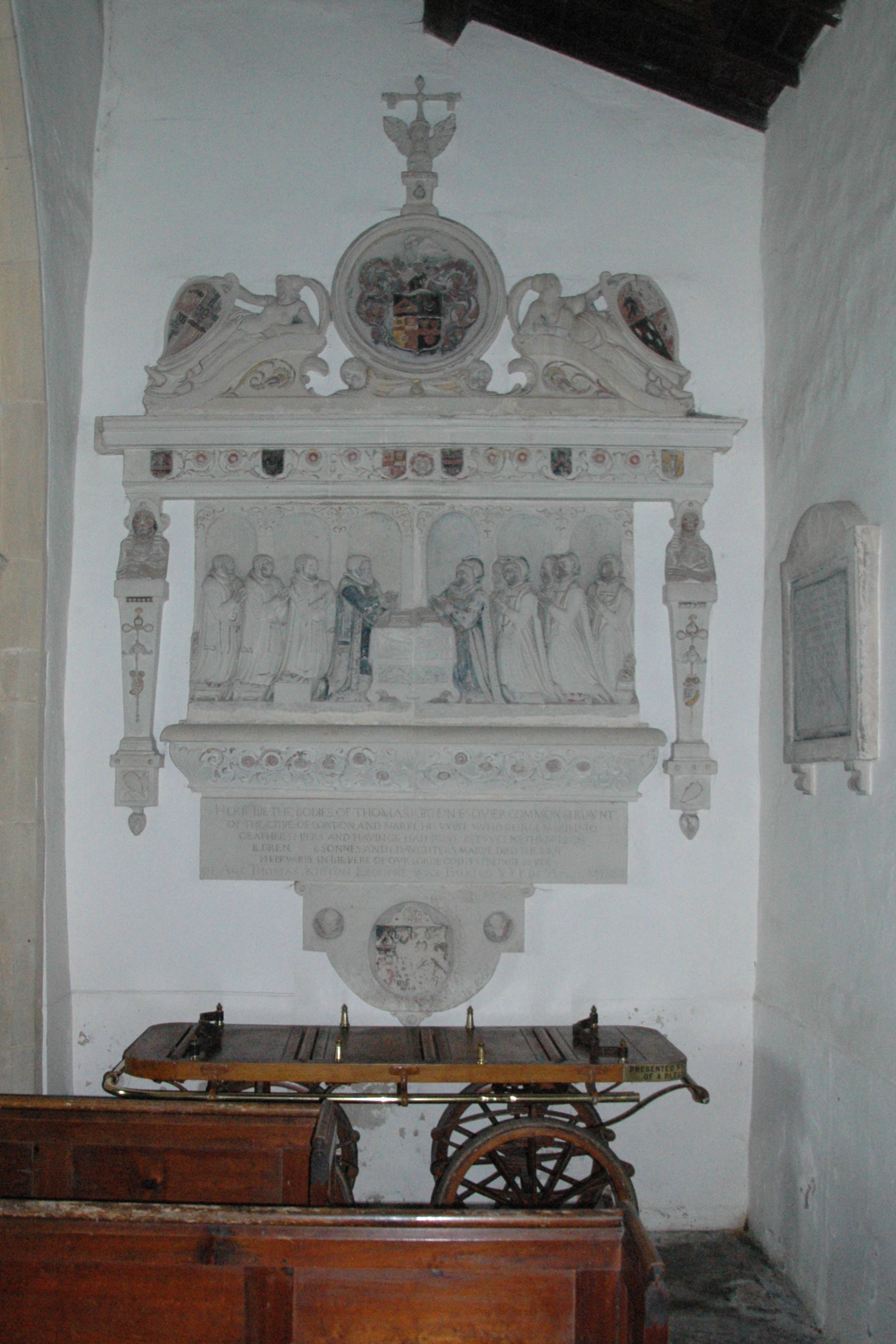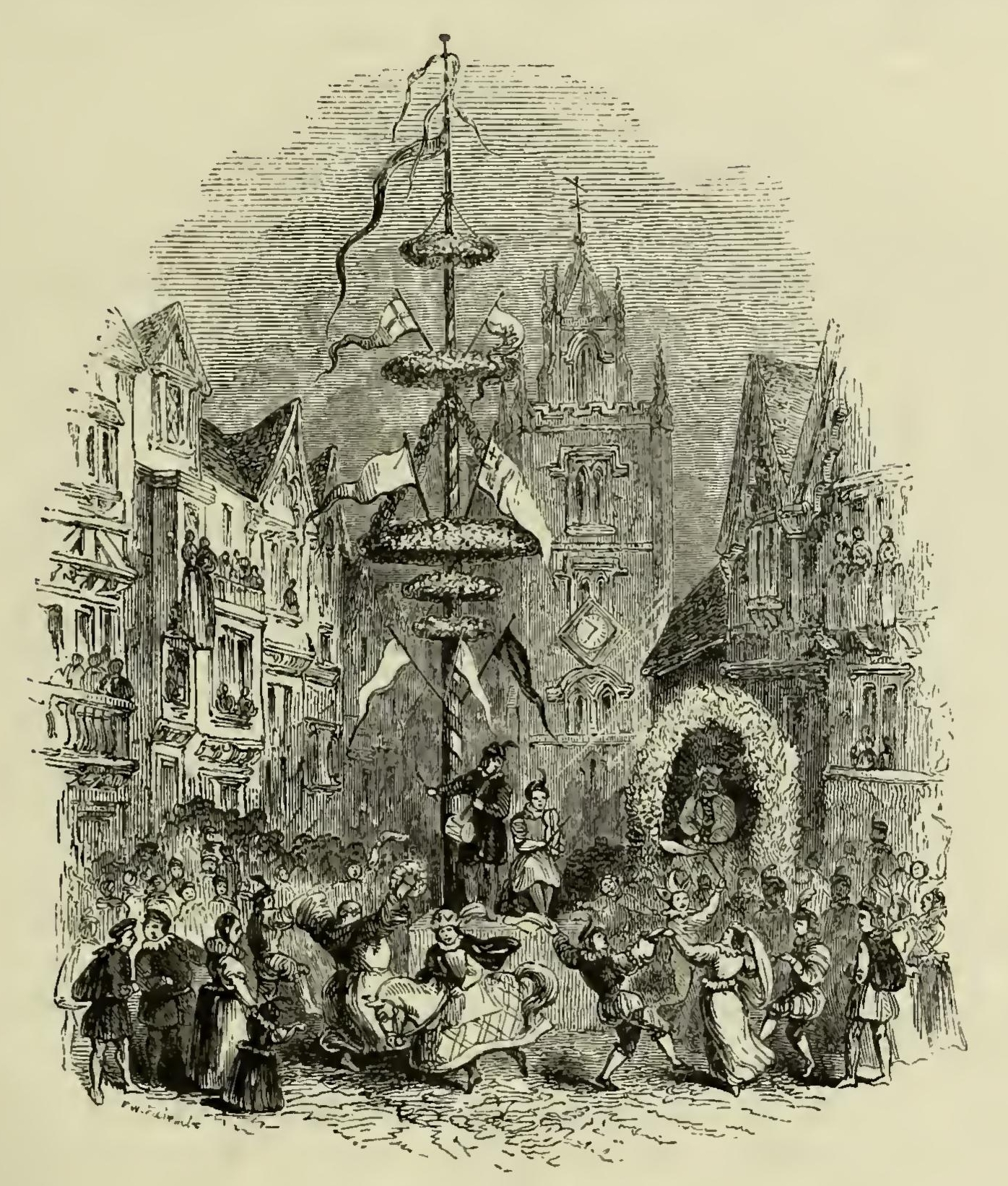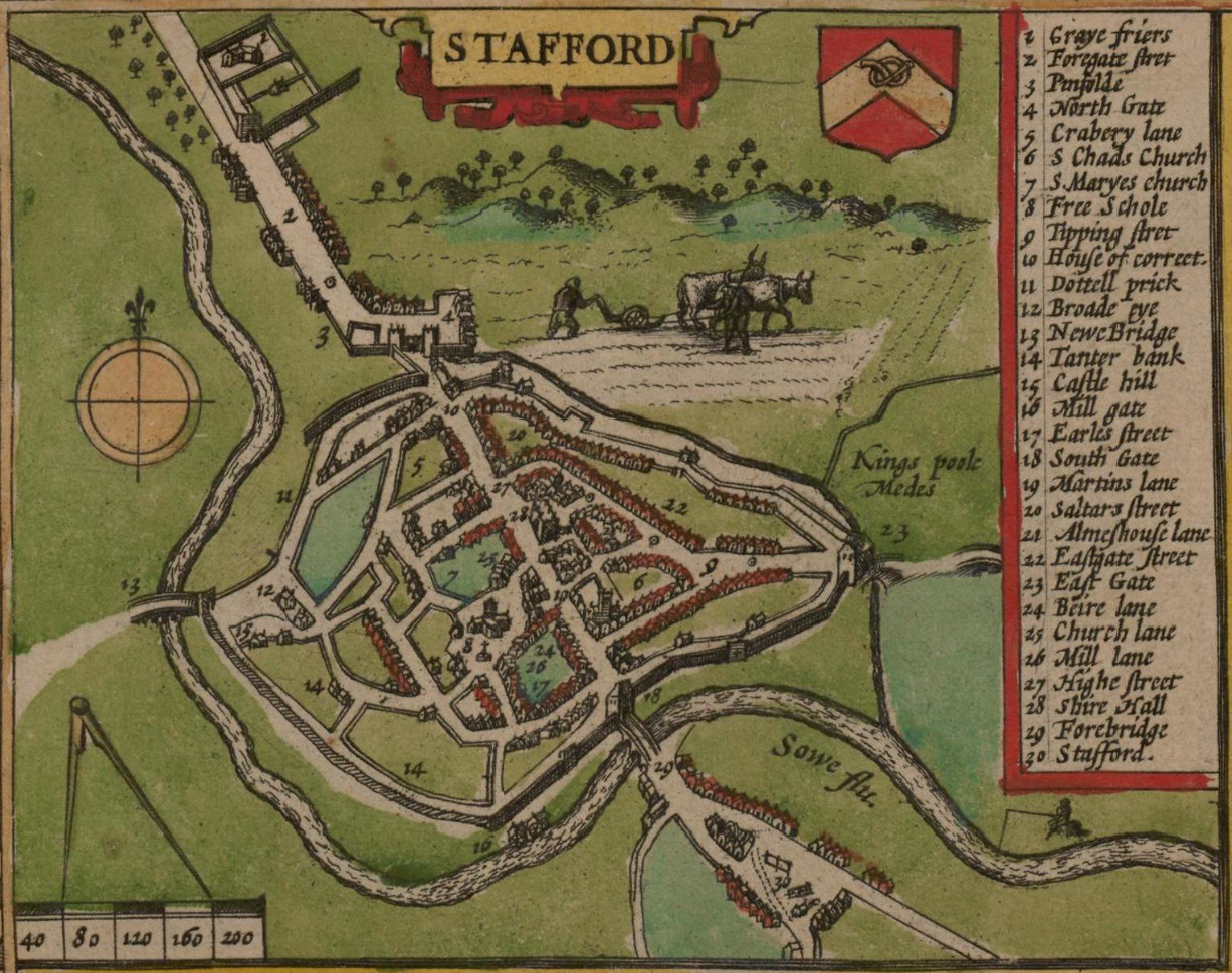|
Nicholas Woodroffe
Sir Nicholas Woodroffe (Woodruff, Woodrofe, etc.) (1530–1598) was a London merchant of the Worshipful Company of Haberdashers, who, through the English Reformation, rose in the Alderman class to become a Master Haberdasher, Lord Mayor of London and Member of Parliament for London. Through the complexities of his family's relationships, and the position and security which they afforded, he lived to establish his family among the armigerous houses of late Elizabethan Surrey. Origins and early life Nicholas Woodroffe's father David (c.1503–1563) was born of a merchant family of Uffculme, Devon, who are supposed to have derived from the Woodroffes of Wolley in Royston, South Yorkshire. Admitted to the freedom of the Haberdashers in 1526, he married within the Company soon afterwards, and like his father-in-law John Hill, Haberdasher, became a Merchant of the Staple at Calais. Hill, 'whose ancestors were of the north,' had married Agnes Mowsdale, a goldsmith's daughter of Londo ... [...More Info...] [...Related Items...] OR: [Wikipedia] [Google] [Baidu] |
Worshipful Company Of Haberdashers
The Worshipful Company of Haberdashers, one of the Great Twelve City Livery Companies, is an ancient merchant guild of London associated with the silk and velvet trades. History and functions The Haberdashers' Company received its first royal charter in 1448 and holds records dating back to 1371. The formal name under which it is incorporated is ''The Master and Four Wardens of the Fraternity of the Art or Mystery of Haberdashers in the City of London''. The company was originally responsible for the regulation of silk and velvet merchants then hatmakers, but began losing control over those trades as the population of London increased and spread outwards from the City after the Industrial Revolution. Through careful stewardship of financial bequests and funds, the company now serves as a significant educational and charitable institution whilst maintaining links with its heritage by giving awards for fashion education. As an educational foundation, the Haberdashers' ... [...More Info...] [...Related Items...] OR: [Wikipedia] [Google] [Baidu] |
Cheap (ward)
Cheap is a small Wards of the City of London, ward in the City of London, England. It stretches west to east from King Edward Street, the border with Farringdon Within ward, to Old Jewry, which adjoins Walbrook; and north to south from Gresham Street, the border with Aldersgate and Bassishaw wards, to Cheapside, the boundary with Cordwainer (ward), Cordwainer and Bread Street wards. The name Cheap derives from the Middle English word "cheep, cheap" for "marketplace, market". The following roads run north to south across the ward: St. Martin's Le Grand, Foster Lane, Gutter Lane, Wood Street, London, Wood Street, Milk Street, London, Milk Street, Queen Street, London, King Street, and Ironmonger Lane. Within its boundaries are two Anglican churches: St Vedast Foster Lane and St Lawrence Jewry; a third church, St Mildred, Poultry, was demolished in 1872. Several Livery Company, Livery Halls are located in Cheap, including those of the Worshipful Company of Mercers, Mercers', Worship ... [...More Info...] [...Related Items...] OR: [Wikipedia] [Google] [Baidu] |
Thomas White (merchant)
Sir Thomas White (7 June 1492 – 12 February 1567) was an English cloth merchant, Lord Mayor of London in 1553, and a civic benefactor and founder of St John's College, Oxford and Merchant Taylors' School. Biography Thomas White was born 7 June 1492 in Reading, Berkshire, the son of William White, a clothier of Reading, and his wife, Mary, daughter of John Kibblewhite of South Fawley, also in Berkshire. He was brought up in London. Sir Thomas was twice married, to Avicia (died 1558) and to Joan. A principal member of the guild of Merchant Taylors, he served as Sheriff of London in 1547, and was elected Lord Mayor of London in 1553. He was knighted in the same year by Queen Mary I. He was a member of the commission for the trial of Lady Jane Grey. In 1555, inspired by the example of Thomas Pope, founder of Trinity College, Oxford, White obtained a royal licence for the foundation of St John's College, Oxford, dedicated to the patron saint of the Merchant Taylors and est ... [...More Info...] [...Related Items...] OR: [Wikipedia] [Google] [Baidu] |
Sheriff Of London
Two Sheriffs of the City of London are elected annually by the members of the City livery companies. Today's Sheriffs have only ceremonial duties, but the historical officeholders held important judicial responsibilities. They have attended the justices at the Central Criminal Court, Old Bailey, since its original role as the court for the City and Middlesex. The Sheriffs reside at the Old Bailey during their year of service, so that one of them can always be attendant on the judges. In Court No. 1 the bench's principal chairs are reserved for their and the Lord Mayor's use, with the Sword of the City hanging behind the bench. It is an invariable custom that the Lord Mayor of London must previously have served as Sheriff. To become a Sheriff, one must be lawfully entitled to armorial bearings by proving their right by descent, whilst those not armigerous by birth can apply for a grant from the College of Arms to run for office. By "custom of immemorial usage in the City" ... [...More Info...] [...Related Items...] OR: [Wikipedia] [Google] [Baidu] |
Thorpe Mandeville
Thorpe Mandeville is a village and civil parish in West Northamptonshire, England about northeast of Banbury in neighbouring Oxfordshire. The hamlet of Lower Thorpe is just north of the village. The village's name means 'Outlying farm/settlement'. The village was held by Richard de Amundevill in 1252. The population of the parish has grown slowly over the centuries. It was recorded as 137 in the 1801 Census, 178 in the 1991 Census, 194 in the 2001 Census and 327 (including Edgcote) in the 2011 Census. Manors The Domesday Book of 1086 records the village as ''Thorp''. "Mandeville" is a corruption of ''Amundeville''. Richard de Amundeville was lord of the manor in the 13th century. In 1346 a house and of land at Thorpe Mandeville were listed amongst the estates of the Augustinian priory at Chacombe. The Kirton family lived at Thorpe Mandeville manor house from 1554 to 1685. Thomas Kirton (1537–1601) of Thorpe Mandeville was Common Serjeant of London. The current i ... [...More Info...] [...Related Items...] OR: [Wikipedia] [Google] [Baidu] |
Achievement (heraldry)
In heraldry, an achievement, armorial achievement or heraldic achievement (historical: hatchment) is a full display or depiction of all the heraldic components to which the bearer of a coat of arms is entitled. An achievement comprises not only the arms displayed on the Escutcheon (heraldry), escutcheon, the central element, but also the following elements surrounding it (from top to bottom): * Slogan (heraldry), Slogan or war-cry * Mantle and pavilion (heraldry), Mantle and pavilion * Crest (heraldry), Crest placed atop a: * Torse (or cap of maintenance as a special honour) * Mantling * Helmet (heraldry), Helm of appropriate variety; if holder of higher rank than a baronet, issuing from a: * Coronet or Crown (heraldry), crown (not used by baronets), of appropriate variety. * Console (heraldry), Console (decorative or aesthetic in purpose, and not officially part of the armorial grant) * Supporters (if the bearer is entitled to them, generally in modern usage not baronets), whi ... [...More Info...] [...Related Items...] OR: [Wikipedia] [Google] [Baidu] |
St Andrew Undershaft
St Andrew Undershaft is a Church of England church (building), church in the City of London, the historic nucleus and modern financial centre of London. It is located on St Mary Axe, within the Aldgate ward, and is a rare example of a City church that survived both the Great Fire of London and the Blitz. The present building was constructed in 1532 but a church has existed on the site since the 12th century. Today, St Andrew Undershaft is administered from the nearby St Helen's Bishopsgate church. History The first church on the site, which today is bordered by St Mary Axe and Leadenhall Street, was built in Middle Ages, medieval times, being recorded in 1147. It was rebuilt in the 14th century and again in 1532; this third incarnation of the building survives today. It is in the Perpendicular style with its entrance located at the base of its off-centre tower. The interior is divided into six bays, with many of the original fittings that survived the Victorian period, Victoria ... [...More Info...] [...Related Items...] OR: [Wikipedia] [Google] [Baidu] |
Mary I Of England
Mary I (18 February 1516 – 17 November 1558), also known as Mary Tudor, was Queen of England and Ireland from July 1553 and Queen of Spain as the wife of King Philip II from January 1556 until her death in 1558. She made vigorous attempts to reverse the English Reformation, which had begun during the reign of her father, King Henry VIII. Her attempt to restore to the Church the property confiscated in the previous two reigns was largely thwarted by Parliament but, during her five-year reign, more than 280 religious dissenters were burned at the stake in what became known as the Marian persecutions, leading later commentators to label her "Bloody Mary". Mary was the only surviving child of Henry VIII by his first wife, Catherine of Aragon. She was declared illegitimate and barred from the line of succession following the annulment of her parents' marriage in 1533, but was restored via the Third Succession Act 1543. Her younger half-brother, Edward VI, succeede ... [...More Info...] [...Related Items...] OR: [Wikipedia] [Google] [Baidu] |
Lime Street (London)
Lime Street is a minor road in the City of London between Fenchurch Street to the south and Leadenhall Street to the north. Its name comes from the lime burners who once sold lime from there for use in construction. It is perhaps best known as the current home of the world's largest insurance market, Lloyd's of London, since its newest building was opened on the street in 1986. Opposite Lloyd's, the Willis Building is the global headquarters of insurance broker Willis. A 35-storey building, The Scalpel, stands at 52-54 Lime Street as the European headquarters of global insurer W. R. Berkley. The northern portion of the street is pedestrianised. Vehicular through-access to Leadenhall Street is prevented by a firegate, forcing drivers to bear right onto Fenchurch Avenue, from which a left turn onto Billiter Street returns vehicles to Leadenhall Street. Nearby is the Norman Foster-designed and gherkin-shaped skyscraper 30 St Mary Axe, and the Leadenhall Building. Leadenhal ... [...More Info...] [...Related Items...] OR: [Wikipedia] [Google] [Baidu] |
Stephen Jenyns
Sir Stephen Jenyns (–1523) was a wool merchant from Wolverhampton, Merchant of the Staple and Master Merchant Taylor who became Lord Mayor of London for the year of the coronation of King Henry VIII. An artistic, architectural and educational patron, he founded Wolverhampton Grammar School, and took a leading part in the rebuilding of the church of St. Andrew Undershaft in the City of London. Origins and early life Stephen Jenyns was, according to the Heraldic Visitations of Staffordshire (1614, 1663 and 1664), the son of William Jenyns of Tenby, Pembrokeshire, and his wife Ellen, daughter and coheir of William Lane of Wolverhampton. He was born at Wolverhampton shortly before 1450, and was apprenticed to a London tailor in 1462–63. He settled in London and became a prominent member of the Fraternity of Taylors and Linen Armourers of St. John the Baptist. In 1485 he and two others supported Hugh Pemberton, a senior Taylor, in a bond for payment of £920 for Pemberton's act ... [...More Info...] [...Related Items...] OR: [Wikipedia] [Google] [Baidu] |
Wolverhampton
Wolverhampton ( ) is a city and metropolitan borough in the West Midlands (county), West Midlands of England. Located around 12 miles (20 km) north of Birmingham, it forms the northwestern part of the West Midlands conurbation, with the towns of Walsall to the east and Dudley to the south. The population in 2021 was 263,700, making it the third largest city in the West Midlands after Birmingham and Coventry. Historic counties of England, Historically in Staffordshire, Wolverhampton grew as a market town specialising in the wool trade. During the Industrial Revolution, it became a major centre for coal mining, steel production, lock making, and automotive manufacturing; the economy of the city is still based on engineering, including a large aerospace industry, as well as the Tertiary sector of the economy, service sector. The city is also home to the University of Wolverhampton. A town for most of its history, it gained city status in the United Kingdom, city status in 2000. The ... [...More Info...] [...Related Items...] OR: [Wikipedia] [Google] [Baidu] |
Stafford
Stafford () is a market town and the county town of Staffordshire, England. It is located about south of Stoke-on-Trent, north of Wolverhampton, and northwest of Birmingham. The town had a population of 71,673 at the 2021–2022 United Kingdom censuses, 2021 census, and is the main settlement within the larger Borough of Stafford, which had a population of 136,837 in 2021. Stafford has Anglo-Saxons, Anglo-Saxon roots, being founded in 913, when Æthelflæd, List of monarchs of Mercia, Lady of the Mercians founded a defensive burh, it became the county town of Staffordshire soon after. Stafford became an important market town in the Middle Ages, and later grew into an important industrial town due to the proliferation of shoemaking, engineering and electrical industries. History Ancient Prehistoric finds suggest scattered settlements in the area, whilst south-west of the town lies an British Iron Age, Iron Age hill fort at Berry Ring. There is also evidence of Roman Brit ... [...More Info...] [...Related Items...] OR: [Wikipedia] [Google] [Baidu] |






